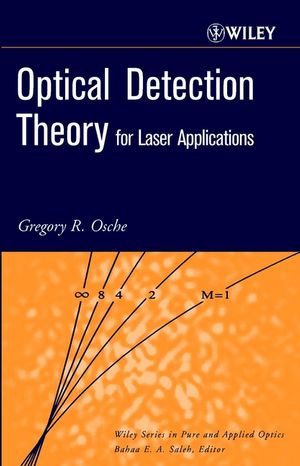Optical Detection Theory for Laser ApplicationsISBN: 978-0-471-22411-2
Hardcover
424 pages
August 2002
 This is a Print-on-Demand title. It will be printed specifically to fill your order. Please allow an additional 15-20 days delivery time. The book is not returnable.
|
||||||
A comprehensive treatment of the fundamentals of optical detection
theory
Laser system applications are becoming more numerous, particularly in the fields of communications and remote sensing. Filling a significant gap in the literature, Optical Detection Theory for Laser Applications addresses the theoretical aspects of optical detection and associated phenomenologies, describing the fundamental optical, statistical, and mathematical principles of the modern laser system.
The book is especially valuable for its extensive treatment of direct detection statistics, which has no analog in radar detection theory and which has never before been compiled in a cohesive manner in a single book. Coverage includes:
* A review of mathematical statistics and statistical decision theory
* Performance of truncated and untruncated coherent and direct detection systems using Huygens-Fresnel and Gaussian beam theories
* Rough surface scatter and atmospheric propagation effects
* Single-pulse detection statistics for direct and coherent detection systems
* Multi-pulse detection statistics for direct and coherent detection systems
Supported by additional comments providing further insights into the physics or mathematics discussed and an extensive list of classic references, Optical Detection Theory for Laser Applications comprises a much-needed reference for the professional scientist or engineer, as well as a solid textbook for advanced students.
Laser system applications are becoming more numerous, particularly in the fields of communications and remote sensing. Filling a significant gap in the literature, Optical Detection Theory for Laser Applications addresses the theoretical aspects of optical detection and associated phenomenologies, describing the fundamental optical, statistical, and mathematical principles of the modern laser system.
The book is especially valuable for its extensive treatment of direct detection statistics, which has no analog in radar detection theory and which has never before been compiled in a cohesive manner in a single book. Coverage includes:
* A review of mathematical statistics and statistical decision theory
* Performance of truncated and untruncated coherent and direct detection systems using Huygens-Fresnel and Gaussian beam theories
* Rough surface scatter and atmospheric propagation effects
* Single-pulse detection statistics for direct and coherent detection systems
* Multi-pulse detection statistics for direct and coherent detection systems
Supported by additional comments providing further insights into the physics or mathematics discussed and an extensive list of classic references, Optical Detection Theory for Laser Applications comprises a much-needed reference for the professional scientist or engineer, as well as a solid textbook for advanced students.



